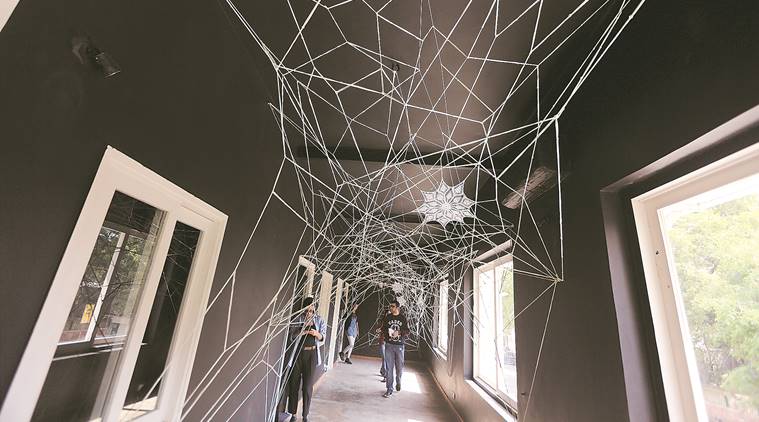Written by Surbhi Gupta |New Delhi |Updated: March 15, 2019 8:40:49 am
A slew of artists explore the relationship between technology, art and nature in an exhibition at KONA, in Delhi’s Jor Bagh Market
The exhibition begins and ends with the artwork by Dutch artist Daan Botlek. He paints his signature figurine of a man and responds to the theme of the exhibition of human lives entangled between technology, art and nature.

The exhibition at KONA, in Delhi’s Jor Bagh Market, doesn’t begin from the front door. There is a guard sitting there instructing people to enter from the backside. But when you peek inside, you get a glimpse of “Temple of Self-Indulgence”, constructed by Singaporean artists Yok and Sheryo. “It is a shrine for social media built by a first generation of human internet adopters,” the artists write in their concept note. Their work is a commentary on people’s devotion to memes, apps, fake news and selfies in today’s world, and social unrest, extreme narcissism and IQ degradation that results from this new-age lifestyle. The Nyan cat, a popular internet meme from 2011, is at the centre of the installation, which is part of the exhibition “F(r)iction”, curated by the St+Art Foundation India. It is part of their ongoing urban art festival in the Lodhi Art District.
The exhibition begins and ends with the artwork by Dutch artist Daan Botlek. He paints his signature figurine of a man and responds to the theme of the exhibition of human lives entangled between technology, art and nature. “The concept of the exhibition began with the idea that how much are we connected with our phones and laptops and how life changes after interactions with technology. The artists respond to the question — ‘we are hyper-connected, but are we?’ How is art changing in execution, and also in consumption by the viewer? It is these frictions and dichotomies that are taking us into a fictional world,” says Guilia Ambrogi, curator and co-founder of St+Art Foundation.
One of the 17 artists who are participating is Mumbai-based illustrator Sajid Wajid, who spent seven days in the small room to create his piece Grey Matter. The exhibit merges his sketches with dhrupad, the ancient styles of Hindustani classical music. “He is popular on Instagram but has not exhibited in a physical space ,” says Ambrogi.
A popular installation at the exhibition is Mumbai-based Hanif Kureshi’s Surfing. It is a room full of small thermocol balls and can be entered, but they get stuck onto the body. A man with a vacuum cleaner helps you get rid of them. The artist makes a comment on the social network, a world which is becoming denser by the day. “We surf through an uncountable volume of information everyday, they get stuck on us, their magnetism is not recognisable at times but is overflowing,” he writes in the concept note.
There is also Polish artist NesPoon, whose installation titled Delhi uses rubber bands and laces, and has been inspired by a tree that she saw on a Polish beach in the winter of 2009. The artist is known to paint harmony and symmetry of lace patterns on the streets and indoor spaces, and modulates it in diverse forms. Nepali artist Kiran Maharjan paints a photo-realistic imagery, using acrylic paint and aerosol, of a human hand and a vulture on the wall. “The artist brings forth the conversation of how the bird species are affected in and around Delhi. Now it’s turning into an un-breathable gas chamber, but our hands are not tight yet,” says the curator.
In one of the rooms, we see Japanese artist Yoh Nagao’s Stars and Dust in which he paints the walls with acrylic paints and there are collages of human figures using magazine cutouts. In another, Akshat Nauriyal uses augmented reality and video in a work titled Hanging in the Void. He shows us that out of the 8000 objects floating in the space around the earth, only 2000 are functional satellites, the rest are debris that make a giant garbage dump in the space. The exhibition culminates on a colourful note with Indian artist duo Do and Khatra’s work Oxygen where the roof is painted in bright hues. “It is an ode to the organic, fluid and the densely nuanced nature of the world,” says Ambrogi.






















No hay comentarios:
Publicar un comentario